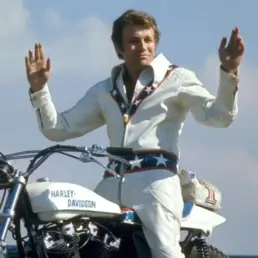These life stories may contain descriptions of childhood trauma and abuse, as well as images, voices and names of people now deceased. If you need help, you can find contact details for some relevant support services on our support page.
American daredevil stuntman and performer, Evel Knievel (1938-2007), was in kinship care as a child.
Robert Craig Knievel was born in Butte, Montana. After his parents separated and left Butte, Robert was raised by his grandparents. He was a good all-round athlete, had early been inspired by racing car driver, George (Joie) Chitwood, and, as the story goes, stole a Harley-Davidson motorbike when he was thirteen.
Knievel did not complete high school; he worked in copper mines for a while and had an assortment of other jobs, including selling insurance. Legend has it that he got his nickname ‘Evel’ while in prison for stealing hubcaps and in a cell next to someone called Awful Knofel. He later changed his name legally.
Knievel joined the Army during the 1950s and made thirty jumps as a paratrooper. After leaving the Army he played hockey professionally for a while.
Knievel’s stunt career began in 1965. In Moses Lake, Washington, Knievel part-owned a struggling motorcycle dealership and, as a stunt to attract customers, “jumped over a caged mountain lion and a few crates of rattlesnakes on his motorbike” (Tuttle).
He became nationally famous when in 1967 he crashed after jumping the fountains at Caesar’s Palace in Las Vegas, footage of which was televised nationally. Two films about Knievel, one in 1971 starring George Hamilton and another in 1976 starring Knievel, indicated his growing celebrity as a “motorcycle daredevil” (Smith, 44), often dressed in a red, white, and blue star-spangled jumpsuit.
Evel Knievel inspired boys growing up in the 1960s and 1970s, many of whom loved the man for his failures as much as for his successes.
“They loved to hear him talk about the times he hadn’t made it over a long line of cars or the fountains in Las Vegas… Many seemed to memorize the way Evel’s body rolled and broke as he crashed” (Collins cited by Smith).
Millions of dollars of Evel Knievel merchandise sold during the 1970s and 1980s, although by 1980 Knievel had retired as a stuntman.
By his own account, he underwent as many as fifteen major operations to relieve severe trauma and repair broken bones—skull, pelvis, ribs, collarbone, shoulders and hips… He had a titanium hip and aluminium plates in his arms and a great many pins holding other bones and joints together. He was in so many accidents that he occasionally broke some of his metal parts, too (Severo).
After retirement, Knievel promoted his son, Robbie Knievel’s career. Robbie had first performed with his father at the age of eight and they toured Australia together in 1979. Robbie Knievel (b. 1962) died on 13 January 2023.
Evel Knievel’s Harley-Davidson XR-750 and jumpsuit are on display at the National Museum of American History.
References:
Severo, Richard. “Evel Knievel, 69, Daredevil on a Motorcycle, Dies.” The New York Times, 1 December 2007. https://www.nytimes.com/2007/12/01/us/01knievel.html
Smith, Jacob. “Seeing Double: Stunt Performance and Masculinity.” Journal of Film and Video, vol. 45, no. 3 (2004), 35-53.
Tuttle, Steve. “American Idol: Evel Knievel, 1938-2007).” Newsweek, vol. 150, no. 24 (2007), 51.
Image available here.
